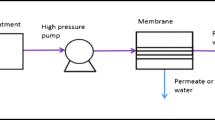Abstract
The performance of two continuous UV/H2O2 photoreactors in series under unsteady-state condition is studied. An input–output dynamic model is constructed to describe the degradation of water-soluble polyvinyl alcohol (PVA) in photoreactors. Identification techniques, AutoRegressive with eXogenous input (ARX) and AutoRegressive Moving Average with eXogenous input (ARMAX), are employed to construct transfer functions. The simulation is carried out for an open-loop operation by applying step changes to the input variables (PVA and H2O2 inlet concentrations and PVA feed flow rate) using the developed model. For effluent total organic carbon (TOC) and H2O2 concentrations as responses, a model predictive control (MPC) scheme is developed to control the photoreactors to maintain desired values of process variables for setpoint and load changes. The closed-loop simulation results show that the multi-input/multi-output (MIMO) MPC produce a good performance for tracking setpoint changes in the TOC and H2O2 concentrates at the photoreactor effluent and it is also able to handle process interactions and constraints. The MPC controller successfully suppresses stochastic disturbances of the inlet PVA concentration.











Similar content being viewed by others
References
Ostacea GS, Baeza J, Guerrero J, Guisasola A, Cristeaa V, Paul S, Agachi E, Lafuente J (2013) Comput Chem Eng 53:164–177
Lucas N, Bienaime C, Belloy C, Silvestre F, Nava-Saucedo J (2008) Chemosphere 73(4):429–442
Mehrvar M, Anderson WA, Moo-Young M (2000) Int J Photoenergy 2(2):67–80
Mehrvar M, Anderson WA, Moo-Young M (2001) Int J Photoenergy 3(4):187–191
Mehrvar M, Anderson WA, Moo-Young M (2002) Adv Environ Res 6(4):411–418
Ghafoori S, Mehrvar M, Chan PK (2014) Chem Eng J 245:133–142
Hamad D, Dhib R, Mehrvar M (2016) J Polym Environ 24:72–83
Hamad D, Mehrvar M, Dhib R (2018) J Polym Environ 26:3283–3293
Nagy ZK, Braatz R (2004) J Process Control 14:411–422
Abouzlam M, Ouvrard R, Mehdi D, Pontlevoyá F, Gombert B, Vel Leitner N, Boukar S (2012) IFAC Proc 16(1):1448–1453
Abouzlam M, Ouvrard R, Mehdi D, Pontlevoyá F, Gombert B, Vel Leitner N, Boukar S (2013) Control Eng Pract 21(1):105–112
Bhadrirajua B, Narasingama A, Kwon J (2019) Chem Eng Res Des 152:372–383
Shen W, Chen X, Corrioub JP (2008) Comput Chem Eng 32:2849–2856
Nogueira IR, Fontes RM, Ribeiro AM, Pontes KV, Embiruçu M, Martins AF (2020) Comput Chem Eng 133:106664
Ostacea GS, Cristea VM, Agachi PŞ (2011) Comput Chem Eng 35:2469–2479
Abouzlam M, Ouvrard R, Mehdi D, Pontlevoyá F, Gombert B, Vel Leitner N, Boukar S (2013) Proceedings of the 3rd international conference on systems and control, Algiers, Algeria
Maria G, Constantinescu C, Ozil P (2002) Comput Aided Chem Eng 8(C):841–846
Özbek M, Bayram G, Özgen C (2014) Polym Eng Sci 54(2):459–465
Chen CL, Hsu SH, Lin WK, Wang TC (2000) J Chin Inst Chem Eng 31(3):283–293
Yoo C, Lee H, Lee I (2002) 15th Terminal World Congress, Barcelona, Spain
Richalet J, Rault A, Testud JL, Papon J (1978) Automatica 14(2):413–428
Qin SJ, Badgwell TA (2003) Control Eng Pract 1:733–764
Stare A, Hvala N, Vrecko D (2006) ISA Trans 45(2):159–174
Zhu Y, Arrieta E, Butoyi F, Cortes F (2002) Hydrocarb Process 79(2):65–72
Jacob NC, Dhib R (2012) J Ind Eng Chem 18(5):1781–1795
Abukhalifeh H, Dhib R, Fayed M (2005) Drying Technol 23:497–511
Acknowledgements
The financial support of the Natural Sciences and Engineering Research Council of Canada (NSERC) and Ryerson University Faculty of Engineering and Architectural Science Dean’s Research Fund is greatly appreciated.
Author information
Authors and Affiliations
Corresponding author
Additional information
Publisher's Note
Springer Nature remains neutral with regard to jurisdictional claims in published maps and institutional affiliations.
Rights and permissions
About this article
Cite this article
Hamad, D., Dhib, R. & Mehrvar, M. Identification and Model Predictive Control (MPC) of Aqueous Polyvinyl Alcohol Degradation in UV/H2O2 Photochemical Reactors. J Polym Environ 29, 2572–2584 (2021). https://doi.org/10.1007/s10924-020-02031-z
Accepted:
Published:
Issue Date:
DOI: https://doi.org/10.1007/s10924-020-02031-z




